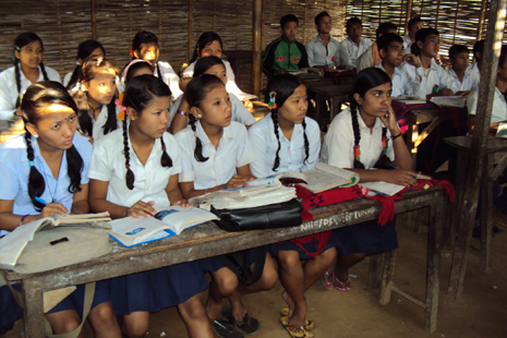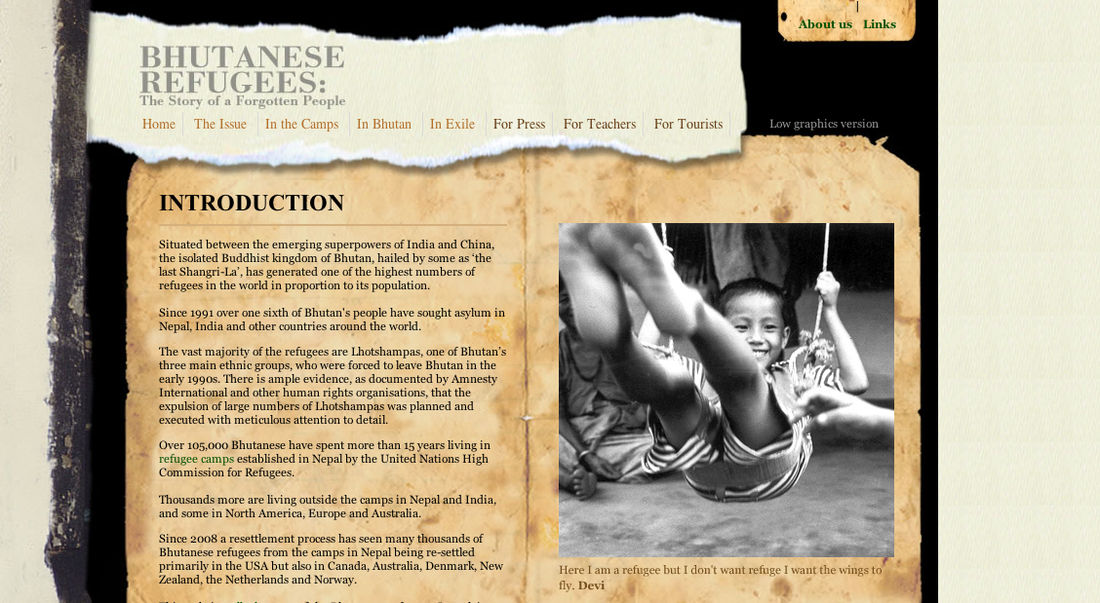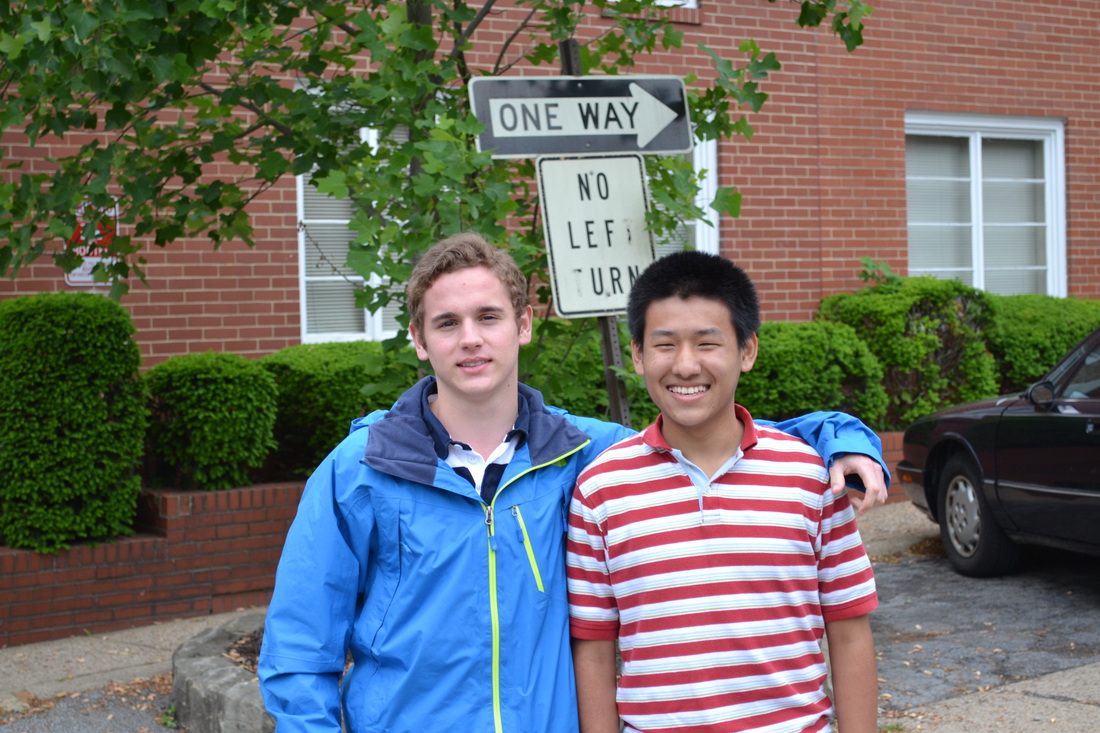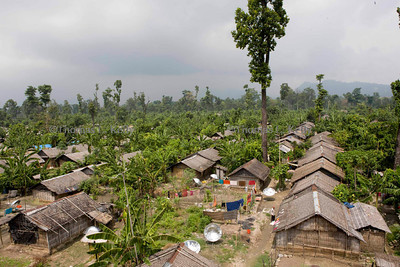I truly feel as though I was able to transcend boundaries as I tried to assimilate myself to another culture as well as I could without actually going to Nepal or Bhutan. I was lucky enough to become friends with Bhutanese Refugees, hear and ask them questions about life in the refugee camps, and do research on my own in order to become extremely knowledgeable about Bhutanese Refugees, where they came from, and their current situation. I feel like I addressed the topic of Diversity by blending both American and Bhutanese perspectives throughout my entire project. I feel like this is particularly evident in my English portion of my project when I actually relate "Invictus" to the life of a Bhutanese Refugee by talking through the poem with Ashish. Finally, I feel like I addressed connectedness by becoming involved in another persons life as well as connecting myself to another culture. I was able to connect with Ashish very easily and I feel like we were able to communicate clearly and effectively with each other regardless of our first languages. I also feel connected to the Bhutanese culture in a way that I wasn't before this project; I am now completely familiar with the topic of Bhutanese Refugees and look forward to meeting up with my new Bhutanese friends in the near future.
Through completing this project I feel like I have shown why I feel I am now a global citizen, I hope you feel the same way too! Enjoy the website...
On my honor I pledge that I have neither given nor received unauthorized help on this assignment, nor have I presented someone else's work as my own.
DWB
http://www.bhutaneserefugees.com
For the English portion of my project I will be reading them my favorite poem Invictus, by William Ernest Henley in order to get their initial reaction as to what it means, how they perceive the ideas within the literature, and if they like it or not. By doing this I hope to branch off into conversation as to what Henley was trying to convey to the reader and if a different perspective is receiving the same message as I did.
A few of the Questions I will be asking them include
a. What was their initial reaction to the poem?
b. What do they think the author is saying in the poem?
c. Do they support the ideas within the poem?
Out of the night that covers me,
Black as the Pit from pole to pole,
I thank whatever gods may be
For my unconquerable soul.
In the fell clutch of circumstance
I have not winced nor cried aloud.
Under the bludgeonings of chance
My head is bloody, but unbowed.
Beyond this place of wrath and tears
Looms but the Horror of the shade,
And yet the menace of the years
Finds, and shall find, me unafraid.
It matters not how strait the gate,
How charged with punishments the scroll.
I am the master of my fate:
I am the captain of my soul.
William Ernest Henley
After reading "Invictus" to Ashish he really liked the idea of overcoming adversity that was prevalent in the poem. I asked him what his favorite line was and he quickly responded, "I have two, 'I am the master of my fate' and 'I am the captain of my soul'." Ashish and I talked about what the poem meant according to how we interpreted it and then I asked him if we could compare the author's hardships to Bhutanese refugees. I compared the lines "I thank whatever gods may be, For my unconquerable soul" to Ashish's own soul, telling him that in my opinion he was a very strong person for having to face the adversity he has been through in his life, he smiled and thanked me. I then looked at the line "I have not winced nor cried aloud" and asked Ashish if he was ever mad about his situation. He responded, "No, I am very grateful for being able to come here and I like it much better here. It's like two different worlds, there is almost nothing in common between the two places." I then related the line to him, telling him that I have never once heard him complain about his situation. We then looked at the first and last line of the third stanza. Ashish and I related the first line "Beyond this place of wrath and tears" to the emotional pain that his ancestors and those who were forced to leave Bhutan must have faced. We then related the last line "Finds, and shall find, me unafraid" to the strength of the refugees being be able to start new lives both in the camps and beyond. As I previously stated the last two lines were Ashish's favorite, but they are mine too. We both agreed that we liked them because they show how we can do anything that we put our minds to and how only we can put a limit on our capabilities.
For the culture portion of this project I will be sharing parts of Pittsburgh's culture with Ashish and Suresh that they might not have experienced otherwise. In addition I hope to learn about the Bhutanese Refugees past, their history, the causes of their current situation. I will analyze human rights and focus on the culture that is present in the refugee camps. By spending time with Ashish and Suresh in Pittsburgh, I hope to have a better understanding about what factors of life are most important to them. Is religion most important? Friends? Family? School? What do they base their lives around? Is it similar or different to what we are used to in America? I will be asking Ashish these questions while also doing my own research to answer these questions and more. A knock comes at your door, it's a government official who has orders to inform you that you are no longer a citizen of this country and that you have limited time to gather all your belongings and flee the country before you are imprisoned. That is the situation that Ashish's ancestors had to face as his family was forced to leave their native country and move to a refugee camp in Nepal. All they had was each other and to this day it seems thats all they need. A Brief History Bhutan is a nation made up of several ethnic groups. One of these is the Lhotshampa, people of Nepali origin, who began to settle in the south of the country in the late 19th century. In the 1980s it emerged that Lhotshampas were being seen as a threat to the political order. When a string of measures were passed that discriminated against their group, the Lhotshampa organised a series of public demonstrations for which the participants were branded as "anti-nationals". Several thousands of Southern Bhutanese were imprisoned, and more than 2000 tortured, according to Amnesty International. Very few of them were formally charged. Thousands fled to India and Nepal. By the end of 1992, there were more than 80,000 living in UNHCR camps in south eastern Nepal. Human Rights Violations - Bhutan has signed only two of the human rights instruments: the Convention on the Rights of the Child (CRC) and the Convention on the Elimination of Discrimination against Women (CEDAW). Therefore the government can be held accountable for violations under these two conventions, strong concerns have been placed regarding the violation of the rights of the children from the Lhotshampa community.
- Rights of the Child - On May 23, 1990, the Royal Government of Bhutan committed itself to fulfilling the rights of all children under its jurisdiction, regardless of their families' ethnicity, language, religion, or culture. However, one year later one-sixth of the Bhutanese population was being expelled from the country and an estimated 120,000 of these were Lhostshampan children under 18. The rights of the refugee children continue to be violated by the Bhutanese government, especially when looking at their right to nationality. Recently the Rights of the Child stated that it: 1) "reports that these children face de facto discrimination in access to education and other services; and 2) alleged discriminatory practices of children on the basis of status, activities, or opinions of their parents, or relatives." The Bhutanese refugee children are still waiting for a just solution meeting their rights to a nationality and all other rights. This includes children born to Bhutanese parents while in exile. Violations against the rights of Bhutanese Refugee children have adversely affected tens of thousands of children and although they may never be adequately compensated they must be fixed.
Culture in the Camps Religion - The two primary religions in the camps include Buddhism and Hinduism however any religion can be practiced in the temples located throughout the camps. When many of the refugees were in Bhutan they were unable to practice many of their religious ceremonies if they were of Hindu origin however they are able to freely practice religion anywhere throughout the camps. This is remarkable to me that different religions are able to coexist in peace when being located in such close proximity to one another. (Even in the same temple!) Family and Friends - Older people are considered very wise because for many refugees they provide a link back to Bhutan and therefore are considered very wise. Even though many refugee children are unable to go to Bhutan and may never be able to in their lifetime they still are taught about Bhutanese history, culture, and proudly show their love and affection for Bhutan. Although refugee people are poor in wealth, they are rich in kindness, helpfulness, and ability towards one another. When I asked Ashish what he centered his entire life around, without hesitation he quickly responded, "My Family!" When asked why, he proudly stated, "they have always been there and I know they always will be." For many refugees their family is the solid rock upon which they can always turn to when faced with adversity. Education - Education has always been very important to the Bhutanese people and was at the forefront of conversation when the refugee camps were constructed. Schools in the camps cater to students from pre-primary level to Class X. These classes taught range from traditional subjects to Dzonkha (Bhutanese national language). In order to receive a higher education however, students must go outside of the camps. There is a limited number of scholarship funds available for further studies and a lot of young people and their families must find a way to fund their higher education; this is very hard to do when limited jobs are available and you have a family to provide for. Recent polls unfortunately have begun to show that the standard of high statistics have begun to slip. In 2004-05, 2,547pupils sat their class X exams with 2,402 passing (a pass rate of 94%). In 2005-06, the pass rate was only 70%. This drop can be accounted for in the lack of quality teachers. Because good quality teachers get paid more at schools outside of the camps, many seek these opportunities leaving less qualified educators to teach the youth inside the camps. As of the 30th November 2006 the number of students attending schools in the camps was 37,403.  Education in Bhutanese Refugee Camps
For the science portion of this project I am taking both Ashish and Suresh to the Carnegie Museum of Natural History in Pittsburgh in order to get their opinion on the topic of Population impact. Some of the questions addressed in the exhibit include, How are the world’s nearly seven billion humans affecting ecosystems? And what effects do changing ecosystems have on humans? Population Impact highlights the research conducted by Carnegie scientists and their colleagues to examine how the choices humans make affect the world in which we live. By giving both my opinion on the topic and asking Ashish and Suresh for their feedback I hope to get not only an American but a global perspective on this issue. The exhibit looks fascinating and I am excited to take our trip into Pittsburgh with my group. More than just that though I want to hear about population impact inside the camps, what was it really like to live inside a refugee camp? My main focus will be to take an issue like Population Impact on a smaller scale, I want to see the effects that Population impact had on Ashish inside the refugee camps. After discussing the issue of Population Impact with Ashish I was extremely taken back by what he had to say. There are seven Bhutanese refugee camps that are located in the Jhapa region of the east Nepali sub tropical lowlands, adjoining the foothills of the Himalayas. Ashish lived in Beldangi-2, the largest Bhutanese Refugee �camp in Nepal, and therefore felt the full effects of population impact. Ashish recalled the small shack-like homes that were practically built on top of each other,offering little privacy or security. Ashish explained to me how everything here is much more spread out while still being accessible. As Ashish recalled the climate is hot and humid, the structural layout is very dense. Each shelter is often under one meter apart and as a result fires occur very frequently. Due to the dense population however there is some competition for resources in the camps such as firewood and bamboo. Beldangi-2 has a population of 22,542 people with 3,358 families, 3,604 huts, and 6.25 people per hut. Ashish tried to paint a picture in my head by asking me to think of my family at home, then my extended family (grandparents, cousins, etc) and then my bedroom at home. He asked me to imagine all of those people living in my bedroom, cooking, sleeping, doing everyday activities, etc. Clearly population impact had a large effect on Ashish in Beldangi -2. As I did more research following my discussion with Ashish I came to find that some 16,673 low-cost temporary shelters, made from local materials, have an expected lifespan of three years over 106,000 refugees in seven camps. Now that the camps are more than ten years old structures such as school buildings and health posts inside the camps are struggling to stay standing on top of flimsy bamboo. There is also only one latrine for every two households a few meters away from their homes. Life in the camps is very cramped however thanks to sanitation volunteers, water and sanitation stations remain clean and of a good standard. All refugee families are given food rations and remain fairly healthy, however non-food items have decreased dramatically in recent years due to the growing population and demand for these goods. Some examples include bathing soap, kerosene, and basic lighting equipment that without access to prevent many of the students from studying at night. In terms of water distribution, the water is centrally controlled and then distributed through pipes, however there is a ration, 25 liters per person per day. Because of some of the conditions in the camps depression, suicide, alcohol and drug abuse, dropping out of school, domestic and gender-based violence and trafficking in girls have all escalated in the camps. Anxiety and depression increase once children reach their final year of education in the camps, a time when they begin to think about how they too will support their families in the refugee camps. Clearly the refugee camps do not harbor the best living conditions and as a result many refugees are very happy to be given the chance to start a new life in a new country. When I asked Ashish if he was excited to come to America he quickly replied, "Yes, The UN was very helpful to my family and I, we are very thankful for the support we received from them." I then asked Ashish if it took a little getting used to coming from a place of such a dense population to a more spread out area, he responded "Yeah, it definitely took a little getting used to but it is much nicer here. I don't have to share a small structure with my family anymore, resources are plentiful, and I feel like I have a better opportunity for a more positive future in America."
David Bantleon
An overhead view of Beldangi-2, the refugee camp where Ashish once lived
|




 RSS Feed
RSS Feed